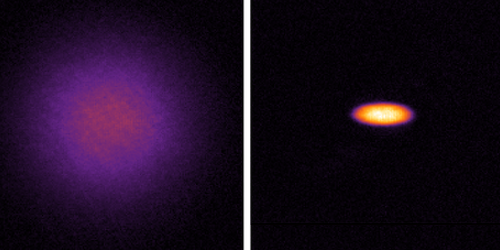A Dense, Cold Gas of Europium Atoms
Since the 1995 creation of the first Bose-Einstein condensate (BEC), researchers have cooled and confined atoms into BECs to study various problems in quantum many-body systems. A BEC’s observable properties depend on the atom being confined. Thus, researchers want to create condensates from as many atomic species as possible. To that end, Yuki Miyazawa of the Tokyo Institute of Technology and his colleagues have now formed a BEC from europium atoms [1]. Europium atoms have a rare symmetric electronic structure, and they interact with one another via strong, magnetic dipole-dipole interactions. This combination of features should lead to a BEC in which the spin-dependent interactions of atoms are smaller than their dipole interactions, an unexplored regime. Thus, the study allows for the possibility of delving into new spin-related phenomena.
To create a BEC from europium, Miyazawa and colleagues confined europium atoms in an optical trap made from two crossed lasers. Reducing the power of one of the lasers, the team evaporatively cooled the atoms while keeping them concentrated in the region where the lasers crossed.
The team produced a BEC containing 5×104 atoms. Using established methods for measuring the short-range interactions between atoms, Miyazawa and colleagues found that they could manipulate the strength of these interactions by applying a very low magnetic field to the BEC. The team says that this control could enable researchers to create novel BEC quantum phases using this system.
In images of the atoms’ spatial distributions, the team also found evidence that both collapse of the BEC and structure formation within it resulted from the strong dipolar interactions of the atoms. This finding indicates that these dipolar actions persist within the BEC and compete with spin-dependent interactions.
–Rachel Berkowitz
Rachel Berkowitz is a Corresponding Editor for Physics Magazine based in Vancouver, Canada.
References
- Y. Miyazawa et al., “Bose-Einstein condensation of europium,” Phys. Rev. Lett. 129, 223401 (2022).




